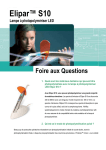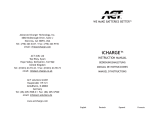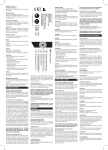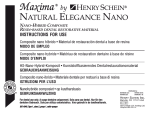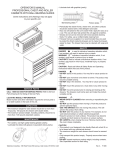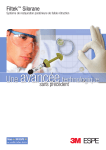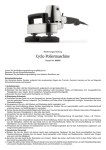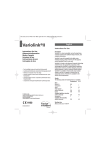Download PoGo - Dentsply International
Transcript
PoGo® One Step Diamond Micro-Polisher DIRECTIONS FOR USE – ENGLISH The PoGo® Polishers (Discs, Cups and Points) are pre-mounted, single-use diamond impregnated cured urethane dimethacrylate resin polishing devices designed for use in the final polishing of all accessible composite resin restorations. When used as directed, the PoGo® Polishing System will yield a high surface luster on hybrid composites such as Esthet•X® Micro Matrix, TPH® Spectrum®, Prisma® TPH®, and Prisma® AP.H® Composites, SureFil® High Density Restorative Material, Quixfil™ and microfilled composite restoratives. The PoGo® Polishing System is also effective in final polishing of compomer and flowable composite and compomer restoratives such as Esthet•X® Flow, X-Flow™, Dyract® AP, Dyract® eXtra and Dyract®flow. STEP BY STEP INSTRUCTION FOR USE Caution: U.S. Federal law restricts this device to sale by or on the order of a dentist. STEP 2: For best results in larger restorations, the use of an intermediate finishing instrument such as an Enhance® Finisher (disc, cup, point) in a conventional contra-angled handpiece will aid in removing scratches and establishing the desired smooth, defect free, matte surface. NOTE: ENHANCE® FINISHERS MUST NOT BE USED IN HIGH SPEED HANDPIECES. In smaller restorations, acceptable surface contours and suitable surface finish may be achieved by the appropriate contouring/finishing instrument. If so, proceed to Step 3. INDICATIONS PoGo® Polishing Discs, Cups and Points are indicated as the final step in polishing all properly contoured and finished composite resin and compomer restorations. COMPOSITION Polymerized Urethane Dimethacrylate Resin Fine diamond powder Silicon Oxide Plastic Latch-type mandrel CONTRAINDICATIONS 1. Do not reuse. PoGo® Polishers are indicated as a single use only, disposable item. Attempts to sterilize, disinfect and/or reuse these items can adversely affect their performance. 2. PoGo® POLISHER SOULD NOT BE USED IN HIGH-SPEED HANDPIECES. WARNINGS 1. PoGo® Polishing Disc, Cups and Points are designed for use without water. As with any rotary instrument, heat will build up with prolonged contact. Use with light intermittent pressure. Application of an air cooling stream during polishing assists with residue removal. 2. Use of the PoGo® Polishers with excessive lateral pressure may dislodge polisher from the mandrel or cause quick deterioration and decreased effectiveness. This type of excess pressure may cause gouging of the restoration surfaces. 3. Care should be taken to have good control on any rotary instrument to protect patients from injury. Contact with soft tissues (gingiva, mucosa) may result in injury to the tissue. If contact occurs, thoroughly wash the affected area with water and seek appropriate medical attention. STEP 1: Place restoration or composite veneer as per standard techniques. Complete gross reduction of excess and general outline form of the restoration using carbide finishing burs (i.e. Prisma® Finishing Burs), Enhance® Finishers or diamond finishing burs. Technique Tip: Prior to proceeding to the PoGo® Polishing System (disc, cup, point) restoration surface should be finished to a desired contour. Surface should be smooth and defect free. STEP 3: Insert a PoGo® Polishing Disc, Cup or Point into a conventional speed contraangled handpiece. NOTE: PoGo® POLISHERS MUST NOT BE USED IN HIGH SPEED HANDPIECES. Begin polishing by applying light intermittent pressure at moderate speed to the restoration surface. When using the disc, the broad surface of the PoGo® Polisher should be used in contact with the restoration to optimize its effectiveness. To increase surface luster, decrease the pressure applied to the restoration surface using a light buffing motion. Technique Tip: 1. PoGo® Polishing Discs are ideal for the facial surfaces and established line angles. 2. PoGo® Polishing Points are ideal for posterior occlusal and concave lingual surfaces. 3. PoGo® Polishing Cups are well suited for cervical and proximal line angle areas. STERILIZATION AND DISINFECTION Do not attempt to sterilize and/or reuse the PoGo® Polishing System (disc, cup or point.) Properly dispose after use. LOT NUMBER AND EXPIRATION DATE 1. Do not use after expiration date. ISO standard used: “YYYY/MM” 2. The following numbers should be quoted in all correspondences. • Reorder number • Lot number on package • Expiration date on package PRECAUTIONS 1. This product is intended to be used as specifically outlined in the Directions for Use. Any use of this product inconsistent with the Directions for Use is at the discretion and sole responsibility of the practitioner. 2. Use in a well ventilated area. Avoid inhaling airborne particulates. 3. Protect adjacent restorations from accidental contact. 4. Storage & Shelf Life: “Dry Storage is Recommended”. Store the PoGo® Polishers Discs between 65˚F-80˚F (18˚C-25˚C) and in relative humidity of 50% ± 20%. Avoid direct sunlight. Do not use after expiry date. ©2002 DENTSPLY International Inc. All Rights Reserved. ADVERSE REACTIONS Allergic contact dermatitis and other allergic reactions may occur in susceptible individuals. Manufactured in the U.S.A. by: DENTSPLY/Caulk P.O. Box 359, Milford DE 19963-0359 1-800-532-2855 Distributed by: DENTSPLY Canada 161 Vinyl Court Woodbridge, Ontario Canada L4L 4A3 PRINTED IN U.S.A. Authorized EU-Representative: DENTSPLY DeTrey GmbH De-Trey-Str. 1 78467 Konstanz Germany Tel.: +49 (0) 75 31 5 83-0 Swiss Representative: DENTSPLY DeTrey Sàrl Oberdorfstr. 11 6342 Baar Switzerland 562021Y (1/20/03) PoGo® One Step Diamond Micro-Polisher INSTRUCCIONES DE USO — ESPAÑOL Los pulidores PoGo® (Discos, Copas y Puntas) son dispositivos de pulido de resina de uretano de dimetacrilato polimeralizada e impregnada de diamante que vienen premontados y son de un sólo uso. Los dispositivos están diseñados para su uso en el pulido final en todo tipo de restauraciones de resina compuesta accesibles. Si se usa según las instrucciones, el Sistema de Pulido PoGo®, produce gran acabado de superficies en compuestos híbridos como Esthet•X® Micro Matrix, Spectrum® TPH®, Prisma® TPH®, y los compuestos Prisma® AP.H®, el material de restauración de alta densidad SureFil®, Quixfil™ y restauradores compuestos de microlleno. El Sistema de Pulido PoGo® es también eficaz en el pulido final de compómeros y composites fluidos como Esthet•X® Flow, X-Flow™, Dyract® AP, Dyract® eXtra y Dyract® flow. Advertencia: La ley federal de los Estados Unidos reserva la venta de este producto a los dentistas y personas designadas por ellos. INDICACIONES Los Discos de Pulido, las Copas y las Puntas PoGo® están indicados para el paso final en el pulido de resinas compuestas y restauradores compómeros correctamente perfilados y acabados. COMPOSICIÓN Resina dimetacrilato de uretano polimerizado Polvo fino de diamante Oxido de silicona Mandril plástico tipo pestillo CONTRAINDICACIONES 1. Úselo una sola vez. Los Pulidores PoGo® están indicados como artículo de un sólo uso y de desecho. Cualquier intento de esterilización, desinfección o reutilización puede afectar negativamente su rendimiento. 2. LOS PULIDORES PoGo® NO DEBEN USARSE CON PIEZAS DE MANO DE ALTA VELOCIDAD. AVISO: 1. Los Discos, Copas y Puntas PoGo® están diseñados para usarse sin agua. Como cualquier otro instrumento giratorio, se calentarán cuando se sometan a contactos prolongados. Se deben usar presionando intermitente y suavemente. La aplicación de una corriente refrigerante de aire durante el proceso de pulido ayuda en la eliminación de residuos. 2. El uso de los Pulidores PoGo® con excesiva presión lateral puede desplazar el pulidor del mandril o causar su rápido deterioro y una disminución de su rendimiento. Este tipo de presión, puede producir también un deterioro de las superficies de la restauración. 3. Debe asegurarse de controlar bien los instrumentos giratorios para evitar lesiones en los pacientes. El contacto con tejidos blandos (encías, mucosa) puede dañar dichos tejidos. En caso de contacto, lave exhaustivamente con agua el área afectada, y busque la atención médica apropiada. REACCIONES PERJUDICIALES En individuos propensos, se pueden producir dermatitis alérgica de contacto y otras reacciones alérgicas. INSTRUCCIONES DE USO PASO A PASO PASO 1: Coloque la restauración o carilla de composite según las técnicas convencionales. Elimine el exceso de material de la restauración mediante una fresa de terminación de carburo (ej. Fresa de Acabado Prisma®), taladros giratorios de diamante o discos impregnados con óxido de aluminio de tamaño grueso y medio. Consejo técnico: antes del uso del Sistema de Pulido PoGo® (disco, copa, punta), las superficies de restauración deberían estar acabadas, teniendo el perfilado final y el contorno deseado y todos los elementos anatómicos. La superficie debería estar lisa y no tener defectos. PASO 2: para obtener los mejores resultados posibles en las restauraciones más grandes, el uso de un instrumento de acabado intermedio como el elemento de acabado Enhance® (disco, copa, punto) en una pieza de mano contra-ángulo convencional ayudará a eliminar arañazos y conseguir la superficie lisa, sin defectos y mate deseada. NOTA: LOS DISCOS DE TERMINACION ENHANCE® NO DEBEN USARSE CON PIEZAS DE MANO A ALTA VELOCIDAD. En restauraciones más pequeñas, se pueden conseguir contornos de superficie aceptables y acabados de superficie apropiados con el instrumento de contorno/acabado apropiado. Si este es el caso, proceda con el paso 3. PASO 3: inserte un Disco, Copa o Punta de Pulido PoGo® en la pieza de mano contraángulo a velocidad convencional. NOTA: EL PULIDOR PoGo® (Disco, Copa o Punta), NO DEBE USARSE EN PIEZAS DE MANO A ALTA VELOCIDAD. Comience el pulido haciendo ligera presión en la superficie de restauración a una velocidad moderada. Cuando se use el disco, la superficie plana y ancha del disco debería utilizarse poniéndola en contacto con la restauración para maximizar su efectividad. Para aumentar el brillo, disminuya la presión ejercida en la superficie de restauración haciendo un ligero movimiento de pulido. Consejo técnico: • Los discos de pulido PoGo® son ideales para las suferficies faciales y los ángulos establecidos. • Las puntas de pulido PoGo® son ideales para las superficies linguales cóncavas y oclusales posteriores. • Las copas de pulido PoGo® son útiles en áreas de ángulos cervicales y proximales. ESTERILIZACIÓN Y MANTENIMIENTO No intente esterilizar y/o re-usar el Sistema de Pulido PoGo® (discos, copas o puntas). Deséchelos en la manera apropiada una vez usados. NUMERO DE LOTE Y FECHA DE CADUCIDAD PRECAUCIONES 1. Este producto está fabricado para ser usado según lo explicado específicamente en las Instrucciones de uso. El uso de este producto de cualquier otra manera a la explicada en las Instrucciones de uso es voluntad y responsabilidad única del profesional que lo utilice. 2. Utilice este sistema en una zona bien ventilada. Evite la inhalación de residuos de pulido. 3. Proteja las restauraciones adyacentes de contactos accidentales. 4. Almacenamiento y Vida Media: „Se recomienda su almacenamiento en lugar seco“. Guarde el Pulidor PoGo® a temperaturas entre 18°C-25°C (65°F-80°F) y una humedad relativa de 50% ± 20%. Evite la luz solar directa. No usar después de la fecha de caducidad. • No use el Sistema si se ha superado su fecha de caducidad. La notación usada es la ISO estándar: „YYYY/MM“ (4 dígitos para año y 2 para mes). • Los números siguientes deben mencionarse en toda correspondencia: • Número de referencia del producto • Número de lote impreso en el estuche • Fecha de caducidad impresa en el estuche PoGo® One Step Diamond Micro-Polisher MODE D’EMPLOI — FRANÇAIS Les instruments à polir PoGo® (disque, cupule, pointe) sont des dispositifs pré-montés, diamantés et jetables en résine diméthacrylate uréthane conçus pour le polissage final de toute restauration en résine composite. En respectant les instructions, les instruments PoGo® permettront d’obtenir un poli parfait des composites hybrides tels que: Esthet•X®, Spectrum® TPH®, Prisma® TPH®, le Prisma® AP.H®, SureFil®, Quixfil™ ainsi que des composites microfinés. Les instruments à polir PoGo® sont également efficaces pour le polissage final des compomères et les composites fluides et des compomères de restauration tels que Esthet•X® Flow, X-Flow™, Dyract® AP, Dyract® eXtra et Dyract® flow. EFFETS INDESIRABLES Avertissement: Usage réservé aux dentistes. Conseil technique: Avant l’utilisation des instruments à polir PoGo® (disque, cupule ou pointe), il faut finir la restauration et lui donner ses contours et ses caractéristiques anatomiques définitives. La surface doit être lisse et sans défaut. INDICATIONS Les disques, cupules et pointes à polir PoGo® sont indiqués pour le polissage final des restaurations en résine composite ou compomère, après modelage et finition convenables. COMPOSITION Résine diméthacrylate uréthane polymérisée Poudre de diamant très fine Dioxyde de silicium Mandrin solidaire en plastique CONTRE-INDICATIONS • Ne pas réutiliser les instruments à polir PoGo® qui sont des instruments jetables à usage unique. Essayer de stériliser, de désinfecter et/ou de réutiliser ces instruments peut nuire à leurs performances. • LES INSTRUMENTS A POLIR PoGo® NE DOIVENT PAS ETRE EMPLOYES AVEC DES PIECES A MAIN A GRANDE VITESSE. ATTENTION • Les instruments à polir PoGo® sont conçus pour être utilisé sans eau. Comme pour tous les instruments rotatifs, un contact prolongé entraînera un dégagement de chaleur. Une utilisation par pression intermittente est recommandée. L’utilisation d’une seringue à air durant le polissage présente l’avantage de chasser les matières résiduelles. • Exercer une pression latérale excessive sur les instruments de polissage PoGo® peut séparer l’instrument du mandrin ou provoquer une usure rapide qui diminuera son efficacité. Ce type de pression excessive peut provoquer une déformation de la surface de la restauration. • Pour éviter de blesser le patient, il est important de garder le contrôle de l’instrument rotatif. Les tissus mous tels que les gencives ou les muqueuses peuvent être blessées en cas de contact accidentel. Si cela se produit, laver soigneusement la partie atteinte avec de l’eau et donner ou faire donner les soins médicaux nécessaires. De l’eczéma de contact ou d’autres réactions allergiques peuvent survenir chez des personnes à risque. MODE D’EMPLOI ETAPE PAR ETAPE Etape 1: Réaliser la restauration ou la facette en composite selon les techniques standards. Effectuer le gros de la finition et terminer les contours de la restauration avec une fraise à finir, une fraise à finir diamantée ou le système de finition Enhance™. Etape 2: Pour obtenir d’excellents résultats sur des restaurations importantes, l’utilisation, au moyen d’un contre angle, d’instruments à finir intermédiaires tels que Enhance® Finisher (disque, cupule et pointe) permettra d’ôter les bavures et de rendre la surface lisse, mate et sans défaut. NOTE: LES INSTRUMENTS ENHANCE® NE DOIVENT PAS ETRE EMPLOYES AVEC DES PIECES A MAIN A GRANDE VITESSE. Pour des restaurations plus petites, une surface aux contours convenables et au fini acceptable peut être obtenue avec des instruments de finition appropriés. Si tel est le cas, passer à l’étape 3. Etape 3: Insérer un instrument de polissage PoGo® dans un contre angle à vitesse normale. LES INSTRUMENTS DE POLISSAGE PoGo® NE DOIVENT PAS ETRE EMPLOYES AVEC DES PIECES A MAIN A GRANDE VITESSE. Commencer à polir la surface de la restauration en exerçant une pression légère avec une vitesse modérée. Lorsque le disque est utilisé, la partie large et plate du disque doit être mise en contact avec la restauration, afin d’augmenter l’efficacité du polissage. Pour améliorer le brillant, diminuer la pression en exerçant de petits mouvements de ponçage. Conseil technique: • Les disques de polissage PoGo® sont particulièrement adaptés aux surfaces vestibulaires et aux angles libres. • Les pointes de polissage PoGo® sont particulièrement adaptées aux surfaces occusales postérieures et aux surfaces linguales concaves. • Les cupules de polissage PoGo® sont destinées aux zones cervicales et proximales inclinées. ENTRETIEN ET STERILISATION Ne pas stériliser ni réutiliser les instruments de polissage PoGo®. Les jeter après utilisation. PRECAUTIONS • Ce produit est prévu pour une utilisation selon les spécifications énoncées dans le Mode d’emploi. Toute utilisation contraire aux spécifications du Mode d’emploi sera de la seule responsabilité du praticien. • Une utilisation dans une pièce bien aérée est recommandée. Eviter d’inhaler les particules issues du polissage. • Protéger les restaurations adjacentes contre tout contact involontaire. • Conservation et péremption: Il est recommandé de conserver les instruments à polir PoGo® dans un endroit sec. Conserver les instruments à polir PoGo® à une température comprise entre 18°C et 25°C, et sous une humidité relative de 50%, + 20%. Eviter l’exposition directe aux rayons du soleil. Ne pas utiliser après la date d’expiration. NUMERO DE LOT ET DATE DE PEREMPTION • Ne pas utiliser après la date de péremption, identifiée conformément à l’ISO: «AAAA/MM» • Les références suivantes doivent être indiquées dans toute correspondance: • Référence du produit • Numéro de lot • Date de péremption figurant sur l’emballage PoGo® One Step Diamond Micro-Polisher GEBRAUCHSANWEISUNG — DEUTSCH Das PoGo® Polier-System (Scheibe, Kelch, Spitze) besteht aus vormontierten, einmalig verwendbaren, mit Diamantstaub imprägnierten und mit Urethan-Dimethacrylat behandelten Polieraufsätzen zum Feinpolieren aller zugänglichen Komposit-Harzrestaurationen. Wenn das PoGo™ Polier-System den Anweisungen entsprechend verwendet wird, erzeugt es auf Hybridkompositen, wie Esthet•X®, Spectrum® TPH®, Prisma® TPH® und Prisma® AP.H®, SureFil®, Quixfil™ sowie mikrogefüllten Komposit-Restaurationen einen starken Oberflächenglanz. Das PoGo® Polier-System ist auch zur Politur von Kompomeren sowie fließfähigen Komposit- und Kompomer-Füllungsmaterialien wie Esthet•X® Flow, X-Flow™, Dyract® AP, Dyract® eXtra und Dyract® flow geeignet. Achtung: Gemäß dem Bundesgesetz der USA darf dieses Produkt nur von einem Zahnarzt oder im Auftrag eines Zahnarztes erworben werden. ANWENDUNG Die PoGo® Polierscheiben, -kelche und -spitzen sind zur Endpolitur aller ordnungsgemäß konturierten und fertig bearbeiteten Komposit- und Kompomer-Restaurationen geeignet. ZUSAMMENSETZUNG Polyurethan-Dimethylacrylat Feines Diamantpulver Siliciumdioxid Kunststoffmandrel KONTRAINDIKATIONEN • Nicht wiederverwendbar! PoGo® Polierer müssen nach einmaliger Verwendung entsorgt werden. Versuche, sie zu sterilisieren, zu desinfizieren und/oder wiederzuverwenden, können ihre Leistungsfähigkeit nachteilig beeinträchtigen. • PoGo® POLIERER DÜRFEN NICHT IN HANDSTÜCKEN MIT HOHER DREHZAHL VERWENDET WERDEN. WARNHINWEISE • PoGo® Polierscheiben, -kelche und –spitzen wurden zur Anwendung ohne Wasser entwickelt. Wie bei jedem anderen rotierenden Instrument kommt es auch bei der Benutzung von PoGo® Polierern bei längerem Oberflächenkontakt zu Wärmebildung. Zur Vermeidung dieser Wärmebildung sollte alternierend mit stärkeren sowie leicht reduziertem Druck poliert werden. Die während der Politur entstehenden Rückstände können mit Hilfe des Luftbläsers entfernt werden. • Die Verwendung von PoGo® Polierern unter zu starkem lateralen Druck kann zur Loslösung des Polierers vom Mandrel, einer schnellen Abnutzung und einer verminderten Effektivität des Polierers führen. Übermäßiger Druck kann Einschnitte an der restaurierten Oberfläche verursachen. • Während der Anwendung von rotierenden Instrumenten ist generell Vorsicht geboten, um Patienten vor Verletzungen zu schützen. Kontakt mit Weichgewebe (Zahnfleisch, Schleimhaut) kann Gewebeverletzungen verursachen. Im Falle einer solchen Verletzung müssen betroffene Stellen gründlich mit Wasser gereinigt und medizinisch angemessen versorgt werden. NEBENWIRKUNGEN Bei prädisponierten Personen kann es zu Kontaktdermatitis und anderen allergischen Reaktionen kommen. SCHRITTWEISE ANWENDUNG SCHRITT NR. 1: Kompositrestauration nach Standardtechnik legen. Zur groben Reduzierung des überschüssigen Materials und Konturierung der Restauration Hartmetallfinierer (z.B. Prisma® Finierbohrer), Enhance® Finisher oder Finierdiamanten verwenden. Technischer Hinweis: Vor Gebrauch des PoGo® Polier-Systems (Scheibe, Kelch, Spitze) sollte die Restaurationsoberfläche die gewünschte Kontur besitzen. Die Oberfläche sollte glatt und defektfrei sein. SCHRITT NR. 2: Für beste Ergebnisse bei größeren Restaurationen wird die Verwendung eines Übergangs-Finierinstruments empfohlen, z.B. eines Enhance® Finishers (Scheibe, Kelch, Spitze) in einem herkömmlichen Winkelstück. Dieser soll zur Entfernung von Kratzern und zur Herstellung der gewünschten glatten, defektfreien, matten Oberfläche beitragen. ANMERKUNG: ENHANCE® FINISHER DÜRFEN NICHT IN HANDSTÜCKEN MIT HOHER DREHZAHL VERWENDET WERDEN. Bei kleineren Restaurationen kann die gewünschte Oberflächenkontur und beschaffenheit mittels entsprechender Kontur-/Finierinstrumente erreicht werden. Anschließend mit Schritt 3 fortfahren. SCHRITT NR. 3: PoGo® Polierscheibe, -kelch oder -spitze in ein Winkelstück mit herkömmlicher Drehzahl einspannen. ANMERKUNG: PoGo® POLIERER DÜRFEN NICHT IN HANDSTÜCKEN MIT HOHER DREHZAHL VERWENDET WERDEN. Die Politur mit mittlerer Umdrehungsgeschwindigkeit und leichtem Druck auf die Restaurationsoberfläche beginnen. Für optimale Ergebnisse muss die flache, breite Oberfläche der Polierscheibe Kontakt mit der Restauration haben. Für erhöhten Oberflächenglanz sollte der auf die Restaurationsoberfläche ausgeübte Druck durch leichte Polierbewegungen reduziert werden. Technischer Hinweis: 1. PoGo® Polierscheiben sind insbesondere geeignet für faziale Oberflächen und die Politur von Winkeln, ohne deren Form zu verändern. 2. PoGo® Polierspitzen sind insbesondere geeignet für Kauflächen und konkav-geformte palatinale und linguale Oberflächen. 3. PoGo® Polierkelche sind insbesondere geeignet für zervikale und approximale Übergangsbereiche. STERILISIERUNG UND INSTANDHALTUNG Das PoGo® Polier-System (Scheibe, Kelch, Spitze) nicht sterilisieren und/oder wiederverwenden. Nach Gebrauch entsorgen! VORSICHTSMASSNAHMEN • Dieses Produkt darf nur gemäß Gebrauchsanweisung verwendet werden. Jegliche anderweitige Verwendung geschieht nach eigenem Ermessen und auf Verantwortung des Benutzers. • In gut belüfteten Räumlichkeiten verwenden. Das Einatmen von Polierrückständen ist zu vermeiden. • Benachbarte Restaurationen vor unbeabsichtigtem Kontakt schützen. • Lagerung und Haltbarkeit: „Trockene Lagerung wird empfohlen.“ PoGo® Polierer bei Temperaturen zwischen 18°C und 25°C (65°F und 80°F) und einer relativen Luftfeuchtigkeit von 50% ± 20% aufbewahren. Vor direktem Sonnenlicht schützen. Nach Ablauf des Verfallsdatums nicht mehr verwenden. CHARGENNUMMER UND VERFALLSDATUM: • Nach Ablauf des Verfallsdatums nicht mehr verwenden. Verwendeter ISO-Standard: „YYYY/MM“: • Die folgenden Nummern sollten bei jeglicher Korrespondenz angegeben werden: • Bestellnummer • Chargennummer auf Verpackung • Verfallsdatum auf Verpackung PoGo® One Step Diamond Micro-Polisher ISTRUZIONI D’USO — ITALIANO I componenti del sistema per lucidatura PoGo® (dischi, coppette e punte) sono premontati, monouso e diamantati, costituiti da una resina in uretano dimetacrilato e concepiti per la lucidatura finale di tutti i restauri in composito. Se usati secondo le indicazioni, il sistema per lucidatura PoGo® è in grado di produrre una superficie altamente lucente dei compositi ibridi quali Esthet•X® Micro Matrix, Spectrum® TPH®, dei compositi Prisma® TPH® e Prisma® AP.H®, SureFil® High Density Restorative Material, Quixfil™, e dei compositi microriempiti. Il sistema per lucidatura PoGo® è anche efficace nella lucidatura di compomeri e compositi flowable e di compomeri da restauro quali Esthet•X® Flow, X-Flow™, Dyract® AP, Dyract® eXtra e Dyract® flow. Attenzione: prodotto ad esclusivo uso odontoiatrico. INDICAZIONI I dischi, le coppette e le punte per lucidatura PoGo® sono indicati per eseguire la fase finale di lucidatura di restauri in composito o compomero opportunamente rifiniti. COMPOSIZIONE Resina polimerizzata di uretano dimetacrilato Polvere fine diamantata Ossido di silicone Mandrino in plastica tipo-lattice REAZIONI AVVERSE Dermatiti allergiche da contatto e altre rezioni allergiche possono verificarsi in pazienti suscettibili. MODO D’USO FASE 1: preparare il restauro o il veneer in composito seguendo le tecniche standard. Effettuare una riduzione degli eccessi o il contorno generale del restauro con delle frese di rifinitura in carburo (es. frese di rifinitura Prisma®), sistema per rifinitura Enhance® o frese di rifinitura diamantate. Consiglio tecnico: prima di usare il sistema per lucidatura PoGo® (dischi, coppette, punte) la superficie del restauro deve essere rifinita nella forma finale, nel contorno e nelle caratteristiche anatomiche desiderate. La superficie deve essere liscia e regolare. FASE 2: per ottenere i migliori risultati nei restauri ampi, l’uso di un sistema di rifinitura intermedio come l’Enhance® (disco, coppa, punta) montato su un manipolo contrangolo convenzionale è di aiuto per eliminare rigature e ottenere una superficie liscia e regolare. NOTA: NON USARE IL SISTEMA PER RIFINITURA ENHANCE® IN MANIPOLI AD ALTA VELOCITÀ. Nei restauri più piccoli, i contorni e le superfici di rifinitura desiderati possono essere ottenuti con gli appropriati strumenti di contornatura e rifinitura. Quindi, procedere alla fase 3. CONTROINDICAZIONI • Non riutilizzare il sistema per lucidatura PoGo® che è stato concepito per un uso singolo. La sterilizzazione, la disinfezione o il riuso di questo prodotto ne compromette la performance. • IL SISTEMA PoGo® NON VA USATO CON MANIPOLI AD ALTA VELOCITÀ. AVVERTENZE • I dischi, le coppette e le punte per lucidatura PoGo® sono state concepite per l’uso senza acqua. Come per ogni strumento rotante, un periodo d’uso prolungato può portare a un surriscaldamento. Lavorare con una leggera pressione intermittente. L’applicazione di un getto di aria fredda durante la lucidatura può essere di aiuto nella rimozione dei residui. • L’uso del sistema PoGo® con un’eccessiva pressione laterale può discolare il dischetto dal mandrino o causare un rapido deterioramento compromettendone l’efficacia. Questa pressione eccessiva può produrre un taglio delle superfici del restauro. • Fare attenzione a tenere sotto controllo ogni strumento rotante per proteggere il paziente da lesioni. Il contatto con il tessuto molle (gengiva, mucosa) può danneggiare il tessuto stesso. In caso di contatto, lavare accuratamente con acqua l’area colpita e consultare un medico. FASE 3: inserire un disco, una coppetta o una punta PoGo® in un manipolo a contrangolo a velocità convenzionale. NOTA: NON USARE IL SISTEMA PoGo® IN MANIPOLI AD ALTA VELOCITÀ. Iniziare la lucidatura applicando una leggera pressione ad intermittenza a velocità moderata sulla superficie del restauro. Quando si utilizza il disco, la più ampia superfice possibile deve essere a contatto con il restauro per ottimizzarne l’efficacia. Per aumentare la lucentezza, diminuire la pressione applicata sulla superficie del restauro facendo ricorso ad un movimento leggero. Consiglio tecnico • I dischi per lucidatura PoGo® sono ideali per le superfici vestibolari e i punti angolati. • Le punte per lucidatura PoGo® sono ideali per le aree occlusali dei denti posteriori e le superfici linguali concave. • Le coppette per lucidatura PoGo® sono ben idonee per le aree cervicali e le zone angolate prossimali. STERILIZZAZIONE E MANUTENZIONE Non cercare di sterilizzare e/o riusare il sistema per lucidatura PoGo® (dischi, coppette, punte). Smaltirli correttamente dopo l’uso. PRECAUZIONI • Questo prodotto deve essere usato secondo le istruzioni d’uso fornite. Ogni uso di questo prodotto diverso da quello previsto nelle istruzioni per l’uso è ad esclusiva discrezione e responsabilità del medico. • Utilizzare il prodotto in una zona ben ventilata. Evitare l’inalazione del residuo di lucidatura. • Proteggere i restauri adiacenti da contatti accidentali. • Conservazione & durata del prodotto : “Si raccomanda la conservazione in ambiente secco”. Conservare il sistema PoGo® tra 65°F e 80°F (18°C e 25°C) e con umidità relativa del 50% ± 20%. Evitare la luce diretta del sole. Non usare il prodotto dopo la data di scadenza. NUMERO DI LOTTO E DATA DI SCADENZA • Non utilizzare il prodotto dopo la data di scadenza. Standard ISO utilizzato “AAAA/MM”. • I seguenti numeri dovranno essere sempre citati in ogni corrispondenza che richiedesse l’identificazione del prodotto: • Numero di codice del prodotto • Numero di lotto sul confezionamento • Data di scadenza sul confezionamento








